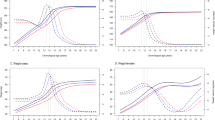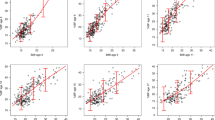Abstract
BACKGROUND: Childhood overweight develops during ‘critical periods’, but the relationship of body mass index (BMI) patterns during ‘critical periods’ from childhood into adulthood with subsequent overweight and adiposity has not been previously investigated. BMI patterns during early childhood, pubescence and post-pubescence and their independent effects on overweight and body fatness at 35–45 y of age were examined along with birth weight and the effects of adult lifestyle factors.
METHODS: BMI parameters describing the timing, velocity minimum (min) and maximum (max) values from 2 to 25 y of age were related to adulthood BMI values and total and percentage body fat (TBF, %BF) at 35–45 y. These data were from 180 males and 158 females in the Fels Longitudinal Study.
RESULTS: There was no sex difference in the timing of BMI rebound, but the age of BMI maximum velocity and maximum BMI were both earlier in girls. Children with an earlier BMI rebound had larger BMI values at rebound and at maximum velocity. Children who reached maximum BMI at later age had larger maximum BMI values. Maximum BMI was a strong predictor for adult BMI and in females, a strong predictor of adulthood TBF and %BF. Maximum BMI was closely related to maximum BMI velocity in females and in males, BMI at maximum velocity is a strong predictor of TBF and %BF.
CONCLUSIONS: Changes in childhood BMI were related to adult overweight and adiposity more so in females than males. BMI rebound is a significant important period related to overweight at 35–45 y in females but not in males. However BMI patterns during and post-adolescence were more important than the BMI rebound for adulthood TBF and %BF status. There is marked tracking in BMI from approximately 20 y into 35–45 y. The pattern of BMI changes from 2 to 25 y had stronger effects on subsequent adult overweight than birth weight and adult lifestyle variables.
This is a preview of subscription content, access via your institution
Access options
Subscribe to this journal
Receive 12 print issues and online access
$259.00 per year
only $21.58 per issue
Buy this article
- Purchase on Springer Link
- Instant access to full article PDF
Prices may be subject to local taxes which are calculated during checkout


Similar content being viewed by others
References
Ogden CL, Troiano RP, Briefel RR, Kuczmarski RJ, Flegal KM, Johnson CL . Prevalence of overweight among preschool children in the United States, 1971 through 1994 Pediatrics 1997 99: e1–e7.
Troiano RP, Flegal KM, Kuczmarski RJ, Campbell SM, Johnson CL . Overweight prevalence and trends for children and adolescents: the National Health and Nutrition Examination Surveys, 1963 to 1991 Arch Pediatr Adolesc Med 1995 149: 1085–1091.
Kuczmarski R, Flegal K, Campbell S, Johnson C . Increasing prevalence of overweight among US adults JAMA 1994 272: 205–211.
Guo S, Chumlea WC, Roche AF, Gardner JD, Siervogel RM . The predictive value of childhood body mass index values for overweight at age 35 y Am J Clin Nutr 1994 59: 810–819.
Must A, Jacques P, Dallal G, Bajema C, Dietz W . Long-term morbidity and mortality of overweight adolescents—a follow-up of the Harvard Growth Study of 1922 to 1935 New Engl J Med 1992 327: 1350–1355.
Dietz W . Critical periods in childhood for the development of obesity Am J Clin Nutr 1994 59: 955–959.
Roche AF, Siervogel RM, Chumlea WC, Webb P . Grading of body fatness from limited anthropometric data Am J Clin Nutr 1981 34: 2831–2838.
Siervogel RM, Guo S, Roche AF . Risk of adult overweight predicted from childhood values of body mass index Abstracts from the Fifth Conference for Federally Supported Human Nutrition Research Units and Centers, National Institutes of Health, Bethesda, MD 1991, p72.
Bray G, York B, Delany J . A survey of the opinions of obesity experts on the causes and treatment of obesity Am J Clin Nutr 1992 55: 151S–154S.
WHO . Obesity: preventing and managing the global epidemic Report of a WHO Consultation on Obesity. Geneva: WHO 1997.
NIH . Clinical guidelines for the identification, evaluation and treatment of overweight and obesity in adults NIH: Bethesda, MD 1998, p1.
Roche AF . Growth, Maturation and Body Composition: the Fels Longitudinal Study 1929–1991 Cambridge University Press: Cambridge 1992.
Lohman T, Martorell R, Roche AF . Anthropometric Standardization Reference Manual Human Kinetics: Champaign, IL 1988.
Chumlea W, Roche A, Siervogel R, Knittle J, Webb P . Adipocytes and adiposity in adults Am J Clin Nutr 1981 34: 1798–1803.
Richardson MT, Be A, Wu H, Jacobs DRJ, Leon AS . Ability of the Atherosclerosis Risk in Communities (ARIC)/Baecke Questionnaire to assess leisure-time physical activity Int J Epidemiol 1995 24: 685–693.
Pols MA, Peeters PHM, Bueno-de-Mesquita HB, Wentink CA, Kemper HC, Collette HJ . Validity and repeatability of a modified Baecke questionnaire on physical activity Int J Epidemiol 1995 24: 381–388.
Jacobs DRJ, Be A, Hartman TJ, Leon AS . A simultaneous evaluation of ten commonly used physical activity questionnaires Med Sci Sports Exerc 1993 25: 81–91.
SAS . SAS user's guide: statistics SAS Institute: North Carolina 1988.
Rolland-Cachera M, Deheeger M, Bellisle F, Sempe M, Guilloud-Bataille M, Patois E . Adiposity rebound in children: a simple indicator for predicting obesity Am J Clin Nutr 1984 39: 129–135.
Rolland-Cachera M-F, Deheeger M, Guilloud-Bataille M, Avons P, Patois E, Sempe M . Tracking the development of adiposity from one month of age to adulthood Ann Hum Biol 1987 14: 219–229.
Guo SS, Chumlea WC, Roche AF, Siervogel RM . Age and maturity related changes in body composition during adolescence into adulthood: the Fels Longitudinal Study Int J Obes Relat Metab Disord 1997 21: 1167–1175.
Guo S, Siervogel RM, Roche AF, Chumlea WC . Mathematical modeling of human growth: a comparative study Am J Hum Biol 1992 4: 93–104.
Braddon FE, Rodgers B, Wadsworth ME, Davies JMC . Onset of obesity in a 36 y birth cohort study BMJ 1986 293: 299–303.
Siervogel RM, Roche AF, Guo S, Mukherjee D, Chumlea WC . Patterns of change in adiposity during childhood and their relation to adiposity at 18 y Am J Hum Biol 1989 1: 136.
Jackson AA, Langley-Evans SC, McCarthy HD . Nutritional influences in early life upon obesity and body proportions. In: Chadwick DJCGC (ed) The Origins and Consequences of Obesity Wiley: Chichester 1996, pp 118–137.
Law CM . Early growth and abdominal fatness in adult life J Epidemiol Community Health 1992 46: 184–186.
Author information
Authors and Affiliations
Corresponding author
Appendix
Appendix
The derivation of BMI parameters from the third-degree polynomial is as follows: 
AVmax is calculated by equating the second derivative of the mathematical function to zero 
Rights and permissions
About this article
Cite this article
Guo, S., Huang, C., Maynard, L. et al. Body mass index during childhood, adolescence and young adulthood in relation to adult overweight and adiposity: the Fels Longitudinal Study. Int J Obes 24, 1628–1635 (2000). https://doi.org/10.1038/sj.ijo.0801461
Received:
Revised:
Accepted:
Published:
Issue Date:
DOI: https://doi.org/10.1038/sj.ijo.0801461
Keywords
This article is cited by
-
The association between the timing, intensity and magnitude of adolescent growth and body composition in early adulthood
European Journal of Clinical Nutrition (2023)
-
Acute effects of inspiratory muscle training at different intensities in healthy young people
Irish Journal of Medical Science (1971 -) (2021)
-
Dietary patterns of university students in the UK: a cross-sectional study
Nutrition Journal (2018)
-
Relationship between obesity and health-related quality of life in children aged 7–8 years
Health and Quality of Life Outcomes (2018)
-
Health-related parental indicators and their association with healthy weight and overweight/obese children’s physical activity
BMC Public Health (2018)



